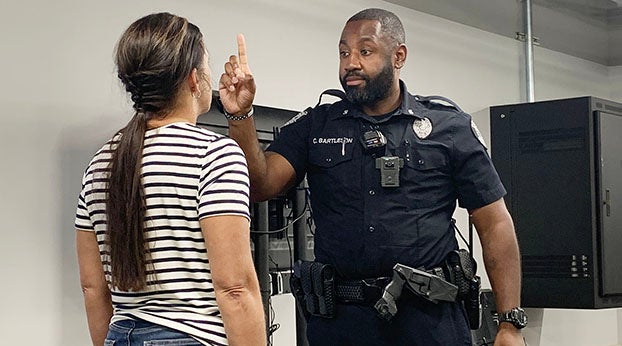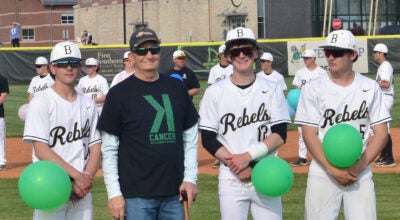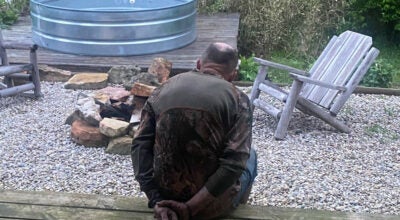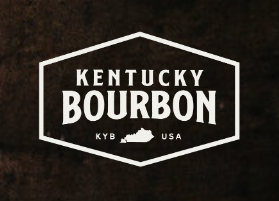Traffic stops are “one of the most dangerous situations” for police officers
Published 2:30 pm Friday, September 25, 2020

- Danville Police Officer Chad Bartelson demonstrates a field sobriety test with class member April Drake during the Danville Police Citizens Academy class Tuesday night. (Jeff Moreland photo)
Editor’s note: This is the sixth in a series of articles written to share the experience of members of the current Danville Police Citizens Police Academy. The 10-week academy will teach the members about all aspects of local police work.
Police officers make traffic stops every day. But Assistant Danville Police Chief Glenn Doan stressed that there is no such thing as a “routine” traffic stop. There are, however, some basic steps that take place in all traffic stops, especially if the officer suspects the driver is under the influence of drugs or alcohol, also known as DUI.
“A standard DUI arrest, that’s going to be over a 2-hour process, because there are certain parameters, certain rules, and regulations that we have to follow to make sure those things are done right. If we skip steps, if we miss steps, that could be grounds to have those cases like that dismissed and thrown out of court,” Doan said. “People will fight a DUI, if they get one, harder than they will fight a murder trial. They’ll go and plead guilty to murder, but they will not plead guilty to driving under the influence. They do not want to lose their license, even though most people that lose them drive anyway. But if you get caught driving with a DUI suspended license, that’s usually an automatic arrest.”
Doan explained to the members of the Danville Citizens Police Academy class that every part of the traffic stop is preparing the officers to make their case once it reaches court.
“Basically, you are building your case block by block from the moment you step out of that car,” he said.
While a DUI is usually thought to be related to alcohol, Doan said most of the DUI cases the department sees are related to narcotics, methamphetamine, or other drugs, and very few are strictly alcohol-related.
From the moment an officer walks up to the vehicle, the driver is already being evaluated. Officer Chad Bartleson said the first thing he notices is the eyes of the driver.
“The first thing I look at are the eyes. Usually, they are bloodshot, glassy, and there’s slurred speech. I usually like to look when they get out of the car, if they’re leaning against the car or if they stumble. There’s a lot of clues you can look at,” he said.
When an officer has the driver get out of their vehicle, the officer will ask if there is any reason the person could not complete any tests of their balance or their eyes. If they say no, the officer goes through the steps of a field sobriety test. Bartleson conducted a demonstration, explaining not only what officers are doing, but what they are looking for as the tests are conducted.
The first test consists of the officer asking the driver to follow his finger as he moves it from left to right. This is known as a horizontal gaze nystagmus test. Bartleson said the main thing officers look for during this test is a movement of the eyes that is not smooth, but rather a jerking motion as they move from side to side.
A walk-and-turn test is also used, and that has the driver place their right foot in front of their left, and then when instructed, walk nine steps heel to toe, make a turn, and walk nine steps back in the same manner.
Bartleson said officers are looking for a lack of balance, such as extreme motion of their arms to maintain balance or simply having great difficulty maintaining balance.
Next, the driver will be asked to stand on one leg, extending the other slightly while counting. The officer will be looking for swaying while balancing, as well as using arms to balance, hopping to balance, or simply putting their foot down to avoid falling. Bartleson said another obvious sign is when a person struggles with the counting portion, sometimes starting the counting over.
If the person says they cannot go through a field sobriety test for any reason, such as a health or medical reason, Doan said there are other ways to test them that anyone can do. He said the driver could be asked to simply count from 1 to 4 and then 4 back to 1 several times. Another test would be to have the driver stand still, close their eyes, and let the officer know when 30 seconds has passed. Bartelson said a person on some types of drugs may only wait a few seconds to reply, while someone under the influence of depressants may stand there for several minutes, not realizing the passing of the time.
After conducting the tests, the officer will usually give the driver a preliminary breath test, or PBT. The number officers are looking for to indicate the driver is under the influence is typically .08, which most people believe is the “legal limit” for intoxication.
“You’ve been lied to your whole life. There’s no such thing as a legal limit,” said officer Daniel Grigsby. “What we call it is a per se limit, and the per se limit is .08, which means after a .08, the courts say without a shadow of a doubt you’re under the influence.”
Grigsby explained that alcohol affects everyone differently, and that’s why there is a per se limit rather than a set number for everyone.
“You can be a .07 or a .06. It all depends on the person. Some people can drink more than others, some people handle alcohol better than others. Forget the legal limit stuff. It does not exist,” he said.
Following the PBT, if the officer determines the person is under the influence, they will then be placed under arrest and taken to the police department where they will be given a more detailed breath test known as the intoxilyzer, but first, they must be read a list of rights known as an implied consent warning, which explains all of the details of the test, as well as the subject’s rights to take or not take the test, their right to contact an attorney, and even the right to have their own blood test administered.
“We have to read this every single time, every DUI,” Bartelson said.
Following the intoxilyzer test, the intoxicated driver would be taken to jail.
Click here to download a copy of Danville PD Implied Consent Warning
Safety during traffic stops
Officers don’t just pull a vehicle over and make their way directly to the window. These days, there are many safety measures taken by officers to be sure they are as safe as possible when making a traffic stop.
First, before even exiting their cruiser, the officer will contact local 911 dispatchers and let them know his location, as well as the license plate number and description of the vehicle being stopped.
Officers will then get out of their cruiser, and if it’s dark outside, they will activate the spotlight on the vehicle, as well as their handheld flashlight.
Bartelson said he uses the spotlight by shining it on the driver’s side mirror of the vehicle he has stopped, which allows him to approach the vehicle without the driver having a good clear view of him.
“If somebody gets out and starts shooting at me, I don’t want them to know where I’m at,” he said.
Often, drivers who are pulled over will immediately begin to gather their personal information, such as their license, registration, and proof of insurance. Bartelson said that is actually not a good idea because officers only see the movement, and can’t be certain if a person is getting that information, or reaching for a weapon.
“We ask people when you’re traffic stopped to put your hands on the wheel, and we’ll give you time to get your information together,” he said.
From the time an officer exits his cruiser, he is focused on safety down to the smallest detail. For instance, Bartelson said an officer is taught to not slam the door of their cruiser, but to close it softly, not making it clear to the driver of the vehicle that he is out of his cruiser.
An officer can go to the driver’s side of the vehicle he has stopped, as well as the passenger’s side. If using the passenger’s side, Bartelson said he would walk behind his own cruiser, then make his way up the shoulder of the road to the vehicle he has stopped.
“You don’t want to walk in between (the vehicles). If he decides he wants to kill me tonight, he can put it in reverse and hit me, and I’m pinned up between cars,” he explained. He added that it’s also a safety concern of another driver on the road accidentally striking the stopped cruiser and injuring an officer between the vehicles.
Once he reaches a vehicle, Bartelson said the officer will introduce himself and tell the person why they were stopped, then ask the driver for their license, registration, and proof of insurance for their vehicle.
“While he’s doing that, there’s nothing wrong with having another unit here with you,” Grigsby said. “They might even be out of the car and watching, but they’re right here with their lights on, giving a little more safety to him.”
Bartelson said the stop typically goes more smoothly if the officer is friendly and polite, asking things such as how the person’s day is going.
Officers do not stand directly beside the vehicle at the driver’s door. Instead, they are taught to stand slightly behind the driver’s door. Grigsby said this allows the officer to be able to quickly move away if a driver were to start shooting at him.
Once he receives the driver’s documents, the officer takes them to his cruiser, all the while looking back at the vehicle as he walks away from it to be sure the person is not getting out of their car. This is for the safety of the officer as well as the driver being stopped. Another safety measure for the officer is to not always go to the driver’s side of their cruiser, but sometimes go to the passenger side.
“My computer is right in the middle of my car, so I can come over here and he doesn’t know where I’m out. If he gets out and decides he wants to hurt me, I’m over here, but they will automatically think I’m here on the driver’s side,” Bartelson explained.
Officers are instructed at the police academy to pull about three feet from the vehicle they have stopped, with their cruiser offset about three feet from the vehicle, according to Bartelson.
Doan added that officers will often follow a driver to a safer location where there is more room for the driver to pull over, making it a safer stop for the officer and driver.
“You want to try to dictate where that stop is going to happen. Maybe I see all these spots by Constitution Square are open, and even though I saw the traffic violation happen at Third and Main, I’m going to wait until we get to Second Street,” Doan explained. “We want to make the situation as safe as we can for not only the operator of the vehicle, but also the officer.”
Grigsby said one safety measure he observes is one he was taught at the academy, but most people may not think about it.
“I don’t turn my flashlight on until I get right up there. When I get to the corner of this car, I touch it right here,” he said, touching the rear driver’s side of the vehicle. “I’ve just left my fingerprints and my DNA on this car. If I get up here and I get shot dead and that car takes off, I’ve left evidence on that car… And I guarantee if they send that car to the lab, the first thing they’re going to do is go back here.”
Doan said traffic stops are by far one of the most dangerous situations officers will find themselves in because of the unknown situations they face.
“You’re taught these tactics and ways to approach and ways to protect yourself,” Doan said. “You can be as nice as you can at this car, and be as courteous and professional as you possibly can, but at the same time, you’re ready to defend your life if you need to. Always.”
Next up: Week 7 of the 2020 Danville Police Citizens Academy is scheduled to continue traffic stops, with class members getting experience facing deadly force during a traffic stop.






